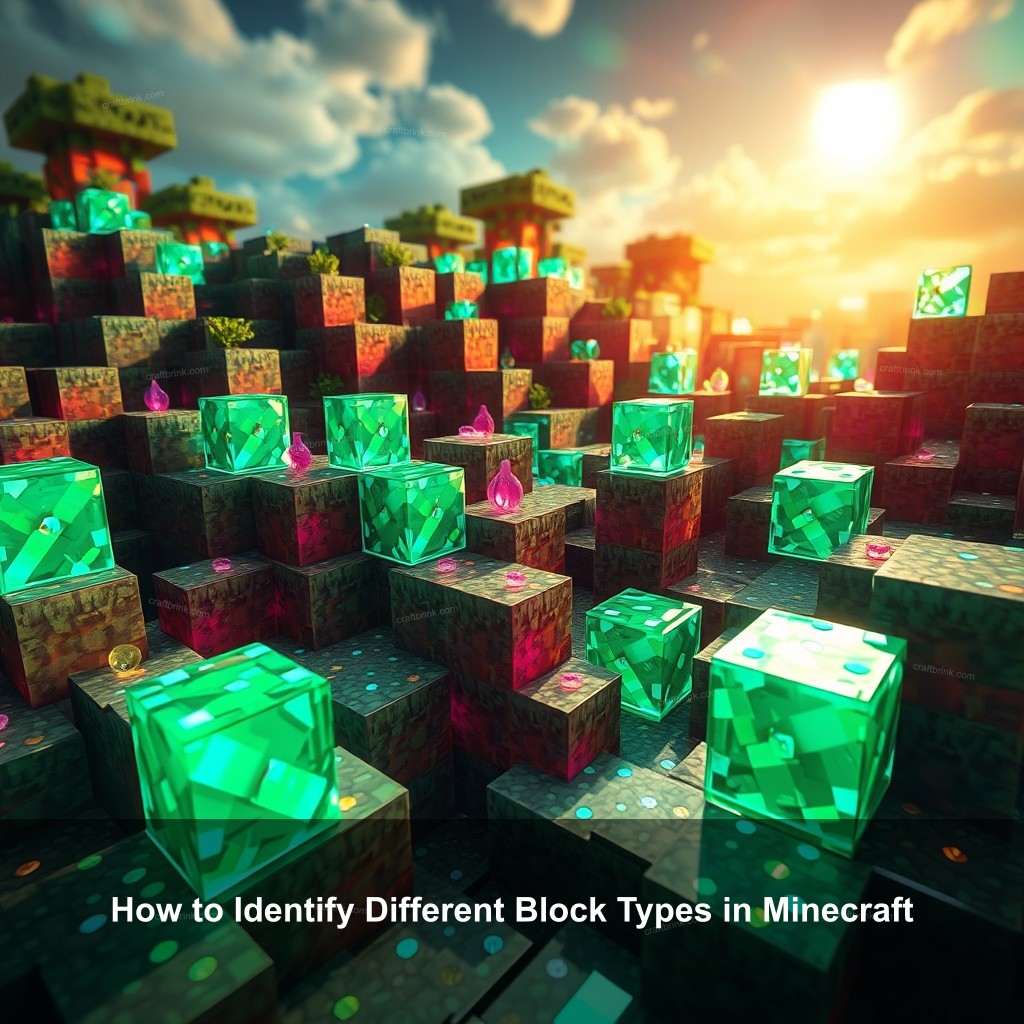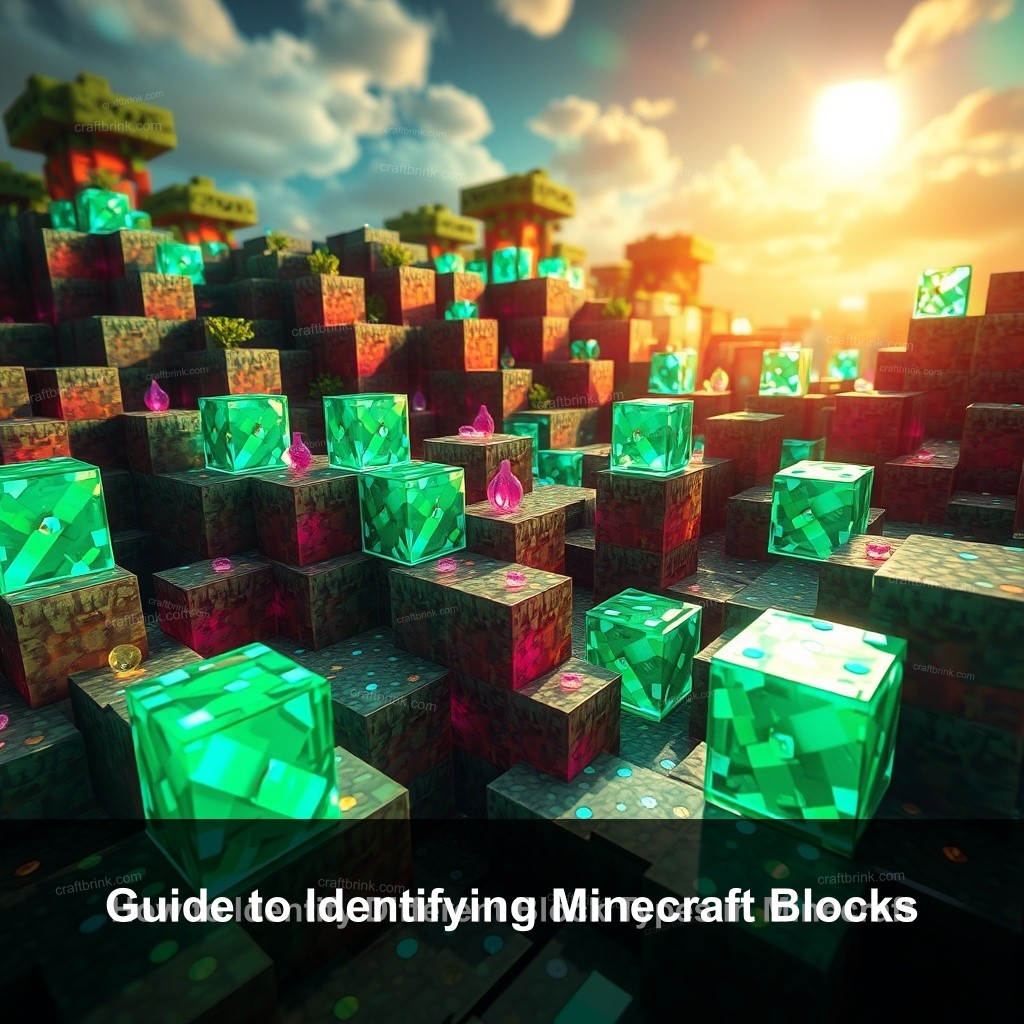Have you ever found yourself staring at a block in Minecraft, unsure of what it is or how to use it? You’re not alone! In this guide by CraftBrink, we’ll help you navigate the world of Minecraft blocks. You’ll learn how to identify different block types, including rare finds and essentials for building. Get ready to improve your gameplay with practical tips and tricks!

Understanding the Basics of Minecraft Blocks
Before we explore identifying specific blocks, it’s important to get familiar with the various types of blocks you can encounter in Minecraft. Blocks in Minecraft serve as the fundamental building components of the game. They can be grouped into several categories based on their properties and behaviors.
The Fundamental Types of Blocks
In Minecraft, blocks are categorized as solid, transparent, or liquid. Solid blocks, such as dirt and stone, form the primary structure of the game world. Transparent blocks, like glass, allow light to pass through but can’t hold any items. Lastly, liquid blocks include water and lava, which can flow and are affected by gravity.
| Block Type | Description |
|---|---|
| Solid Blocks | Form the primary structure, like dirt and stone. |
| Transparent Blocks | Allow light to pass through, e.g., glass. |
| Liquid Blocks | Flowing blocks such as water and lava. |
Block Properties and Characteristics
Each block has unique properties that dictate how players can interact with them. For instance, some blocks, like obsidian, are resistant to explosions, while others, such as sand and gravel, can fall when there is nothing beneath them. Knowing these attributes helps you work with blocks effectively in your builds.
Importance of Block Identification
Knowing how to identify blocks is important for crafting and building. It allows players to make informed decisions about which materials to use in construction or when crafting items. For a deeper dive into different types of blocks, check out our Comprehensive Guide to Minecraft Block Types.

How to Identify Different Block Types in Minecraft
Identifying blocks can sometimes be challenging, especially for new players. But fear not! Here are some effective techniques and resources to help you recognize various block types.
Visual Identification Techniques
One of the simplest ways to identify blocks is by their appearance. Each block has a unique texture and color. For example, grass blocks have a distinct green top, while sand blocks are a lighter yellow hue. Familiarizing yourself with the textures can greatly improve your ability to identify blocks quickly.
- Identify blocks by their unique textures.
- Focus on color variations to distinguish between similar blocks.
- Use visual guides available online as references.
Tools and Resources for Identification
Utilizing tools can simplify the identification process. Various mods and apps are available that provide detailed information about blocks, including their properties and uses. Websites and forums dedicated to Minecraft can also be excellent resources for quick references.
Recognizing Rare Blocks
Some blocks, like emerald ore, are hard to find in Minecraft. They are often hidden in specific biomes or at particular depths. By learning the locations and conditions under which these rare blocks appear, you can improve your mining strategy and increase your chances of finding them.
Block Identification for Beginners
If you’re new to Minecraft, block identification can seem overwhelming. However, with a few simple strategies, you’ll be identifying blocks like a pro in no time!
Beginner’s Guide to Block Recognition
Start by focusing on a handful of common blocks. Dirt, stone, wood, and cobblestone are primary materials you’ll encounter frequently. Maintaining a checklist or a visual guide can help reinforce your learning.
Common Mistakes in Block Identification
Many beginners confuse similar-looking blocks. For example, cobblestone can easily be mistaken for stone due to their similar appearances. It’s important to pay attention to subtle differences or ask seasoned players for help when unsure.
Getting Help from the Community
Engaging with the Minecraft community can be beneficial for new players. Forums and social media groups offer a wealth of knowledge and support. You can ask questions, share your discoveries, or even join a multiplayer server for collaborative learning.
Advanced Block Identification Techniques
As you become more experienced, the methods to identify blocks can evolve. Here are some advanced techniques to enhance your skills.
Understanding Block Behavior
Different blocks behave in unique ways when interacting with the game mechanics. For example, understanding that gravel falls and that sand can suffocate entities can influence how you build and mine. Make sure to get familiar with these behaviors to avoid surprises.
Practical Applications of Block Identification
Knowing how to identify blocks can greatly improve your construction skills. For instance, using a variety of blocks not only improves the visual appeal of your builds but also ensures effective functionality. Consider combining different block types for a more creative approach!
Using Enchantments and Tools for Block Interaction
Certain tools can aid in block identification and collection. For instance, using Silk Touch allows you to harvest blocks like grass or ores without breaking them down. This skill can be particularly helpful for preserving the block’s original form for later use.
Block Traits and Uses in Minecraft
Understanding the traits and uses of blocks is mandatory for any Minecraft player. Here, we’ll examine commonly used blocks and how to utilize them effectively.
Commonly Used Blocks and Their Functions
Blocks like wood, stone, and iron are staples in any Minecraft player’s inventory. Each has distinct functions; for example, wood can be crafted into a variety of items, while stone is often used for building foundations.
Understanding Block Interactions
Blocks can interact in numerous ways to create complex systems. For instance, Redstone can connect with blocks to create circuits and other functional devices. By knowing these interactions, you can improve your gameplay and create intricate machines.
Building with Different Block Types
When constructing, consider using various blocks to improve the visual appeal and functionality of your structures. Experiment with different textures and colors to find your unique style. For more ideas, check out our article on the Top 10 Minecraft Building Blocks.
Tips and Tricks for Effective Block Identification
Mastering block identification takes practice, but these tips will guide you along the way.
Quick Identification Tips
One helpful tip is to use mnemonics to remember block types. Associating colors or textures with specific names can help reinforce your memory.
Utilizing In-Game Resources
Take advantage of the crafting menu for identification. This menu can show you which materials are needed for crafting various items, helping you recognize their corresponding blocks.
Learning from Gameplay Experience
Your experiences while playing are valuable. Keep track of the blocks you encounter and their uses. Over time, you will develop a better understanding of how different blocks function.
FAQ
What are the most common blocks in Minecraft?
The most common blocks include dirt, stone, wood, and cobblestone. They are mandatory for crafting and building.
How do I identify rare blocks in Minecraft?
Rare blocks, like emerald ore, are typically found in specific biomes or depths. Familiarize yourself with their locations to increase your chances of finding them.
Can I use mods to help with block identification?
Yes! Several mods are available that provide detailed information about blocks, including their attributes and uses.
What is the importance of block properties?
Knowing block properties is important for gameplay. It influences your building strategies and affects how you interact with your environment.
How can I improve my block identification skills?
Practice makes perfect! Engage with the community, use resources and continually familiarize yourself with different block types.
Conclusion
Identifying Minecraft blocks is a skill that every player should develop. By knowing the properties and uses of various blocks, you can improve your gameplay and creativity. Don’t hesitate to share your experiences and questions in the comments below. Visit CraftBrink for more insights and guides that will improve your Minecraft journey!
